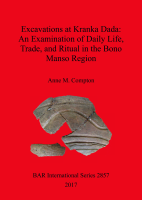Description
The Bono Manso region of central Ghana was occupied from the late 12th to mid-18th centuries CE, spanning much of the zenith of the sub-Saharan and Atlantic Trade eras. Bono Manso was a nascent urban centre near a primary trade route that linked the Malian city of Jenne with the Akan goldfields. By integrating new archaeological data with oral, historical and archival data, the author discusses how the satellite village of Kranka Dada and its domestic economies were shaped by regional, continental and global trade and interaction. A household-oriented focus allows for discussion of how daily life at Kranka Dada, the economic, political and religious organization, were shaped by interaction with Bono Manso.
AUTHORS
Anne M. Compton is an adjunct professor of anthropological archaeology at the University of New Mexico. She completed her PhD in 2014 at the University of Michigan.
REVIEWS
‘By focusing on households in a village community, this monograph further develops an important “bottom-up” perspective on long-term political economic dynamics much-needed in the archaeology of West Africa.’ Peer reviewer
‘Whereas a number of scholars have begun to examine the long-term histories of village life in relatively “peripheral” regions such as nearby Banda, this is one of the first studies to examine change and continuity in a village set within the orbit of a major political-economic centre.’ Peer reviewer
‘The author provides detailed descriptions of produced goods, trade items, and structures at Kranka Dada, placing the household centrally within this analysis, and ensuring a perspective that captures the majority of the population hidden from view in the historical record...The author develops a new ceramic typology system for the study area, which is a significant contribution.’ Dr Sarah Walshaw, Simon Fraser University











